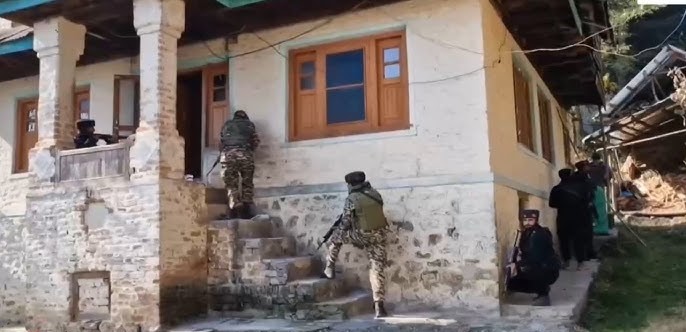1,500 Detained in Kashmir as Authorities Crack Down on Terror Network | Massive Raids Target ‘Terror Ecosystem’
By: Javid Amin | 10 November 2025
In a massive, coordinated security operation, nearly 1,500 individuals have been detained across Jammu and Kashmir as authorities intensify efforts to dismantle what officials describe as the “terror ecosystem” — a network allegedly responsible for funding, facilitating, and ideologically sustaining militancy in the region.
The large-scale crackdown, one of the most extensive in recent months, was launched following specific intelligence inputs suggesting the reactivation of sleeper cells, renewed cross-border coordination, and fresh recruitment attempts in southern and northern districts of the Valley.
Massive Raids Across the Valley
Over the last 48 hours, joint teams of the Jammu and Kashmir Police, Central Reserve Police Force (CRPF), and intelligence agencies carried out synchronized raids in Pulwama, Kulgam, Anantnag, Shopian, Baramulla, Kupwara, and Bandipora.
Sources within the police confirmed that the action is both preventive and investigative, designed to disrupt militant support channels before they can translate into on-ground violence.
“This is part of an ongoing effort to neutralise the support network that keeps terrorism alive through logistics, funding, and ideological motivation,”
a senior police officer told Kashmir In Focus on condition of anonymity.
Dozens of residential premises, internet cafés, and small business units were searched during the raids, with digital devices, financial ledgers, and communication equipment seized for forensic analysis.
Officials added that many of those detained are not formally arrested but are being questioned and screened to verify their level of involvement in facilitating militant activity.
Who’s Being Picked Up?
The ongoing crackdown targets multiple layers of alleged facilitators that sustain insurgency infrastructure beyond the armed cadres.
According to official sources and local reports, the detainee categories include:
1. Overground Workers (OGWs)
-
Individuals accused of providing safe houses, food, transportation, and intelligence to active militants.
-
Several are suspected to have links with banned outfits such as Lashkar-e-Taiba (LeT), Jaish-e-Mohammed (JeM), Hizbul Mujahideen (HM), and The Resistance Front (TRF).
2. Recruiters and Radical Influencers
-
Suspects allegedly involved in radicalising youth through social media propaganda, encrypted chats, and religious gatherings.
-
Authorities claim some of these individuals are part of “online indoctrination cells” with handlers based in Pakistan or PoJK (Pakistan-occupied Jammu & Kashmir).
3. Financial and Logistic Enablers
-
Businesspersons and NGOs suspected of diverting funds through hawala channels, charitable fronts, and cryptocurrency transactions.
-
Several white-collar professionals, including a few doctors and educators, have been detained for alleged involvement in financial or logistical support to militants.
4. Former Militants and Released Detainees
-
Individuals previously associated with insurgent outfits, who remain under surveillance due to continued communication with known operatives.
Officials say that among those detained are known OGWs from southern districts and a few individuals under watchlists for the last several months.
Why Now? The Timing Behind the Crackdown
The timing of this operation is seen as strategic, coming just weeks before the winter closure of mountain passes, when cross-border infiltration typically decreases and local networks become the primary operational link for militants.
According to senior security officials, fresh intelligence inputs suggested an attempt by Pakistan-based groups to reactivate dormant cells in southern Kashmir, aided by radical online propaganda and funding through NGOs and social media drives.
“We’re witnessing a shift from armed infiltration to digital radicalisation and financial facilitation.
The crackdown aims to cut those invisible lines before they become lethal,”
said a senior intelligence officer involved in the operation.
The recent arrest of two doctors from south Kashmir for allegedly providing logistical aid to militants, and the seizure of unaccounted money and communication devices, further reinforced fears that the terror-support infrastructure was expanding beyond traditional militant networks.
A Shift from Reactive to Preventive Counter-Terror Strategy
Officials describe the ongoing operations as part of a “preventive doctrine”, marking a shift in counter-terror policy from reacting to attacks to neutralising enablers before violence erupts.
Earlier strategies largely focused on eliminating active militants through gunfights and cordon operations.
Now, the emphasis is on disrupting recruitment chains, funding channels, and propaganda nodes.
Key Focus Areas of the Preventive Approach:
-
Target digital networks promoting radical ideologies.
-
Map financial transactions linked to cross-border handlers.
-
Crack down on overground facilitators rather than waiting for militant movement.
-
Encourage community intelligence sharing through civil administration.
Security officials believe this ecosystem-centric approach will deliver sustainable results, reducing the number of local recruits and the frequency of attacks.
Follow the Money: Financial Tracking Under Scanner
Investigations have also widened into money trails linked to suspected terror funding.
According to sources in the National Investigation Agency (NIA), several of those detained are being probed for their connections with hawala networks, illegal money transfer channels, and NGO-linked donations from abroad.
Authorities suspect that some of these funds are being diverted toward logistics, recruitment incentives, and online propaganda.
The Enforcement Directorate (ED) is also expected to join the probe to trace financial irregularities connected to cross-border funding.
“The goal is not just to arrest individuals but to crush the ecosystem that feeds militancy—from ideology to money to manpower,”
a senior NIA officer said.
Ground Impact: Fear, Compliance, and Mixed Reactions
Across the Valley, the sweeping detentions have evoked a mix of relief and concern.
Security Perspective
Many residents, especially in towns affected by repeated militant activity, support the crackdown, calling it essential to restore normalcy.
“We have lived through decades of bloodshed. If this operation prevents another attack or saves even one life, it’s justified,”
said a trader in Pulwama.
Civil Liberties Concerns
However, rights activists and some community leaders express concern about due process and transparency.
They argue that mass detentions without formal charges could alienate innocent civilians and erode trust between citizens and the administration.
Human rights organisations, including Amnesty International India (now restricted) and local advocacy groups, have called for independent oversight of such operations to ensure accountability.
“Security cannot come at the cost of civil liberties,”
said a Srinagar-based lawyer, adding that temporary detentions must not become indefinite incarcerations.
Officials maintain that screening protocols are being followed and that innocent individuals will be released after verification.
Digital Footprints Under Scrutiny
Investigators are also analysing social media activity and digital communications of detainees to identify links with foreign handlers or extremist content networks.
Cyber surveillance units within the J&K Police have tracked encrypted chats, Telegram channels, and WhatsApp groups used for:
-
Recruitment messaging
-
Sharing of operational guidance
-
Circulation of extremist videos and manifestos
Officials confirm that several smartphones and laptops have been seized for forensic extraction, and data will be cross-matched with national intelligence databases.
This reflects a growing recognition that online radicalisation has become a core component of modern insurgency.
Coordination Between Agencies
The ongoing crackdown represents unprecedented coordination between J&K Police, NIA, CRPF, Army intelligence units, and central intelligence agencies.
A multi-agency task grid reportedly coordinates daily updates, ensuring that information from local police stations feeds directly into the Integrated Intelligence Command Network.
Each district’s Senior Superintendent of Police (SSP) has been assigned zone-specific targets, ensuring geographic coverage across all ten districts of the Kashmir Valley.
Public Messaging: “Peace Through Prevention”
The J&K administration has framed the operation as a peace-preserving measure rather than a punitive one.
In an official statement, the Director General of Police (DGP) reiterated that the mission aims to “secure communities, not suppress them.”
“Our priority is public safety and stability. Every measure taken is guided by law and national security imperatives,”
the DGP said.
“We are dismantling the networks that push young people toward violence.”
The administration has also urged parents, teachers, and religious leaders to play proactive roles in identifying and discouraging radical tendencies among youth.
The Numbers Behind the Crackdown
| Parameter | Approx. Figures (as of Nov 6, 2025) |
|---|---|
| Total detained | ~1,500 individuals |
| Districts covered | 10 (entire Valley) |
| Seized devices | 600+ phones, 120 laptops |
| Suspected OGWs under formal arrest | 200+ |
| Pending verifications | 800 cases under review |
| Recovered cash/documents | ₹1.3 crore in unaccounted funds |
(Source: J&K Police internal briefing, verified by Kashmir In Focus)
Broader Context: Countering the “Ecosystem” Narrative
The term “terror ecosystem”, now central to official narratives, reflects a conceptual expansion of counter-terrorism.
It suggests that the roots of militancy extend beyond the gun — into propaganda, logistics, politics, and even psychology.
Analysts note that the current doctrine mirrors global trends in counter-extremism, focusing on disrupting the enablers rather than only neutralising militants.
“Modern terrorism thrives on networks, not just individuals,”
said Lt. Gen. (Retd.) Rakesh Sharma, a former Northern Command officer.
“Kashmir’s strategy seems to be evolving in that direction—cutting the web before it spins another cycle of violence.”
Bottom-Line: A Critical Moment for Kashmir’s Security Landscape
The ongoing operation marks one of the largest coordinated security crackdowns in recent years in Kashmir, reflecting a new phase in India’s counter-insurgency policy.
While authorities frame it as a preemptive strike to preserve peace, critics warn of overreach and alienation if transparency is not maintained.
The success of the mission will depend on two delicate balances:
-
Security efficiency vs. civil liberty protection, and
-
Preventive control vs. public trust-building.
As Kashmir continues its slow journey toward political stability and economic revival, how this operation unfolds—and how fairly it is executed—may well shape the next chapter of peace and governance in the region.


